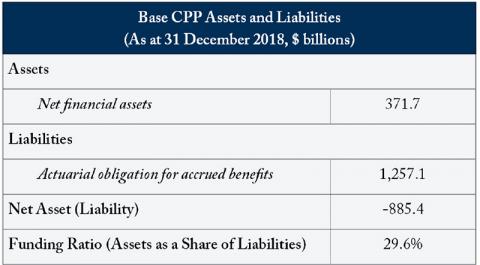From: Alexandre Laurin
To: Canadian Pension Watchers
Date: December 17, 2020
Re: Is the Canada Pension Plan in a Net Asset Position? No, and it’s Not Supposed to Be
Analysts often report that the Canada Pension Plan (CPP), and its parallel Quebec Pension Plan (QPP), are in a substantial “net asset” position. Canadians did accumulate assets in these plans at a rapid rate over the last 20 years, but one should not forget the liabilities: the value of pension benefits accrued and owed to retired Canadians is still about 3.4 times the size of the assets.
Cross-country comparisons of government debt are complicated by sometimes irreconcilable differences in country measurements, leading to different interpretations of a government’s financial situation. A major point of differences between jurisdictions is the treatment of government obligations for future pension benefits. Retirement systems vary considerably around the world, and most countries still ignore the present value of unfunded retirement benefits in calculating their net debt.
In many countries, government employee pensions are intertwined with social security insurance schemes. Such schemes provide social benefits for personal risks such as loss of income due to unemployment, the cost of medical services, or income protection in retirement. They are typically financed through annual contributions dedicated to cover their annual cost that is a pay-as-you-go funding formula. Under the system of national accounts and the international Government Finance Statistics convention, social security scheme’s financial flows are treated as any other current government revenues and expenses: these programs do not give rise to a government liability for future entitlements. Unfortunately, the CPP, and its parallel QPP, fall under this classification.
So when Statistics Canada reports on the income statement and balance sheet of these plans, under the international Government Finance Statistics convention, it shows only in-year flows, and the surplus of contributions (and investment income) over benefits that has accumulated over the years. It is thus often reported that the CPP and QPP are in a “net asset” position – in the sense that financial assets exceed liabilities.
This terminology is unhelpful and misleading because it fails to consider the value of the pension obligations owed to workers and retirees. CPP program parameters and eligibility are legislated, and workers do expect and plan their retirement on the expectation that they will receive their legislated pension benefit entitlements when they become eligible. And the CPP is not a social security scheme in which a single future government can unilaterally alter its commitments – major reforms require the consent of at least seven of the 10 provinces representing two‑thirds of the Canadian population. The generic internationally based justification for ignoring future pension liabilities does not fit the CPP well.
Not showing the pension liabilities makes our public pension plans appear to be in a substantial “net asset” position – about 20 percent of GDP in the latest PBO long-term sustainability report. Add the pension liabilities, and our public pension plans are in a considerable net debt position.
For example, view the CPP as a public defined-benefit pension plan providing retirement benefits to working Canadians, and the net assets in the plan ($371.7 billion as at December 31, 2018) are much lower than the actuarial value of accrued pension obligations ($1,257.1 billion), resulting in a net liability of $885.4 billion (see Table). This is how federal and provincial employee pension plans are accounted for, and reflected in governments’ net debt. Therefore, combining the balance sheets of all levels of governments – including the CPP and QPP – on the same chart requires showing the net debt of public pension plans – $885.4 billion in the case of the CPP. Showing only the net financial assets gives a false sense of security in the combined balance sheet of Canadian governments.
This does not mean, however, that the CPP is not sustainable in the future under its partially funded arrangement. View the CPP as a mandatory federal/provincial social security retirement system – in which under an implicit social contract current contributors allow the use of their contributions to pay current beneficiaries’ benefits (pay-go system) – and the present value of future pension benefits to be paid to born and unborn participants ($2,674.4 billion) exceeds the present value of future contributions ($2,319.4 billion) by $355 billion, which is pretty much the current value of net financial assets. This means that enough assets accumulated to cover the future shortfall of contributions.
So depending on how one views the plan, the CPP either has a huge unfunded liability, or has future contributions and assets expected to viably finance all future benefits. But in no case is the CPP in a substantial “net asset” position.
Source: Actuarial Report (30th) on the Canada Pension Plan.
Alexandre Laurin is Director of Research at the C.D. Howe Institute.
To send a comment or leave feedback, email us at blog@cdhowe.org.
The views expressed here are those of the author. The C.D. Howe Institute doesn’t take corporate positions on policy matters






